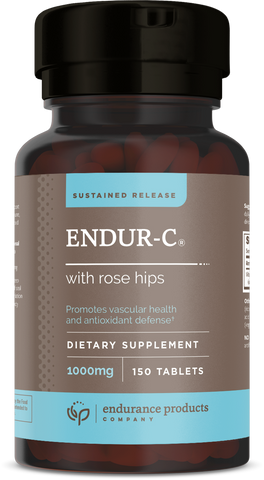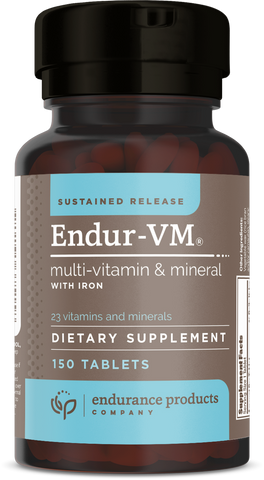It’s no secret that most people don’t get the nutrients they need. And as they get older, things only get worse. To stave off the mid-life pounds, most people are slashing calories. And the demands they put on their bodies make our need for nutrition even greater.
Unfortunately, the most recent Dietary Guidelines for Americans points out that several vitamins and minerals are being under consumed in this country.
But in order to be in the best health we can be, we need to make sure we’re giving our bodies what they need to flourish. This means not only filling your daily plate with nutrient-rich foods, but taking a complete daily multi like ENDUR-VM® Multi-Vitamin & Mineral for dietary insurance, especially on those days when food choices fall short.
Why a daily multi? Results from a recent study may hold the key. Researchers at Tufts University in Medford, Massachusetts looked through the most recent government data that included survey results from over 10,000 adult men and women. The study found that with the exception of a few nutrients, frequent use of a multivitamin and mineral supplement virtually eliminated nutrient shortfalls!1
Ready to fill those nutrient gaps that are holding you back? Here are three of the nutrients you’re likely to be lacking:
1. Vitamin C
Why you need it. Also known as ascorbic acid, vitamin C is a water-soluble nutrient, which means your body doesn’t store any excess. (You urinate it out.) Vitamin C acts as an antioxidant, so it can either stop the formation of free radicals (oxygen molecules that can damage healthy cells) or disable them before they do harm.
Vitamin C also helps the body to produce collagen, a vital protein used to make skin, cartilage, tendons, ligaments, and blood vessels. And it helps support the immune system.
How much do you need? The NIH recommends adult women get at least 75 mg and adult men get at least 90 mg every day. If you smoke, (which you should not!) add 35 mg to the above amount.
Where to get it? Vitamin C is found in fresh fruits and vegetables, especially citrus fruits. Steamed broccoli or Brussels sprouts or fresh strawberries all provide about 100 mg of vitamin C per one-cup serving. That goes double for raw sweet peppers with almost 200 mg of vitamin C per one-cup serving.
2. Vitamin D
While we get some vitamin D from foods like fatty fish, fortified orange juice and milk, we manufacture most of it in our bodies when the ultraviolet rays from the sun strikes the skin. We need it help the body absorb calcium in the gut, one of the body’s main building blocks for bone growth. We also need D in order for movement, as it plays a role in muscle contraction. The immune system also uses vitamin D to help fend off foreign invaders. Vitamin D is fat-soluble, meaning it dissolves in fat and is stored in the body.
Unfortunately, because we’ve been told to stay out of the sun and slather on sunscreen, many Americans don’t get the vitamin D they need. And as we age our ability to synthesize D gets less efficient.
How much do you need? The NIH recommends adults up to 70 years of age get at least 600 IU of D daily. Folks 71 and older need 800 IU daily.
Where to get it? Unfortunately, vitamin D is not found naturally in a whole lot of foods. At least, not a whole lot that we eat regularly. Fish like trout and salmon provide about 600 IU per 3-ounce serving, and many foods are currently fortified with vitamin D, including milk and cereals.
3. Vitamin E
Like vitamin D, E is fat-soluble. And like C, it acts as an antioxidant, helping to protect cells against the ravages of free radicals. Other benefits of vitamin E include maintaining normal immune system function, cell signaling, and blood vessel dilation.
How much do you need? The NIH recommends adults get at least 15 mg of vitamin E per day.
Where to get it? Vegetable oils—wheat germ, sunflower, safflower, and even olive oil—are good sources of vitamin E. And you can’t beat nuts and seeds as a convenient source. Almonds, for example, provide about 8 mg of vitamin E per ounce as do sunflower seeds.
We think multi-vitamins are just about the most important dietary supplement you can take. Which is why we formulated ENDUR-VM® tablets with advanced, sustained-release nutrient delivery. This high-potency formula provides over 20 essential vitamins and minerals, including vitamins C, D and E, along with vitamin A, energizing B vitamins, and trace minerals.*
If you need help making this healthy habit stick, check out these five tips to help you stay on track.
In the meantime, fill your plate with nutrient-rich foods! Now, who wants a snack?
About Endurance Products Company
Endurance Products Company has been a trusted source of quality dietary supplements since 1978. Our sustained-release and extended-release tablets feature a unique vegetable wax matrix that releases nutrients in a slow, steady manner over a period of hours for optimal nutrient absorption and retention.
References
1. Blumberg JB, Frei BB, Fulgoni VL, Weaver CM, Zeisel SH. Impact of frequency of multi-vitamin/multi-mineral supplement intake on nutritional adequacy and nutrient deficiencies in U.S. Adults. Nutrients. 2017;9(8). pii: E849. PMID: 28792457.
* These statements have not been evaluated by the Food and Drug Administration. This product is not intended to diagnose, treat, cure or prevent any disease.


